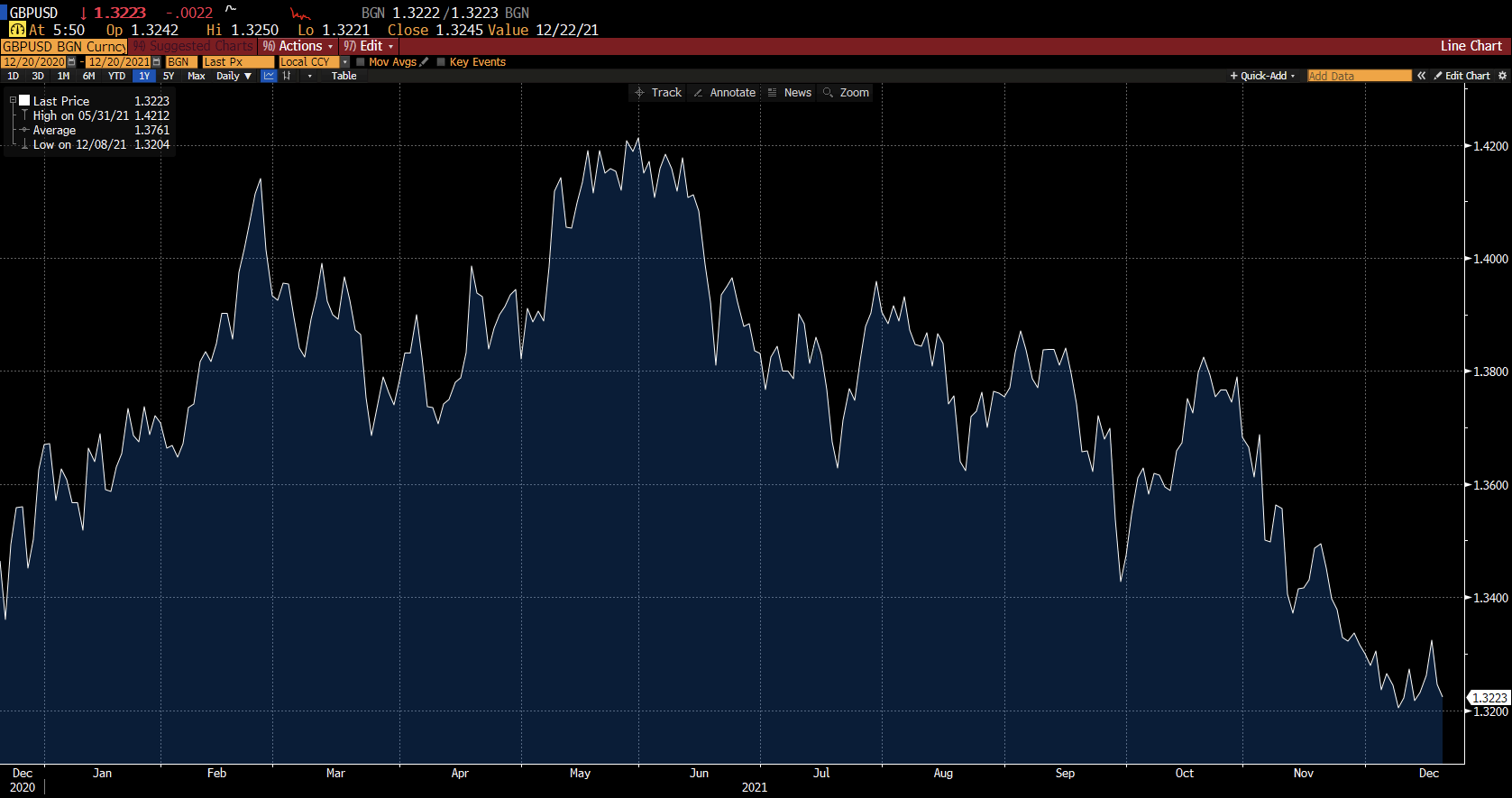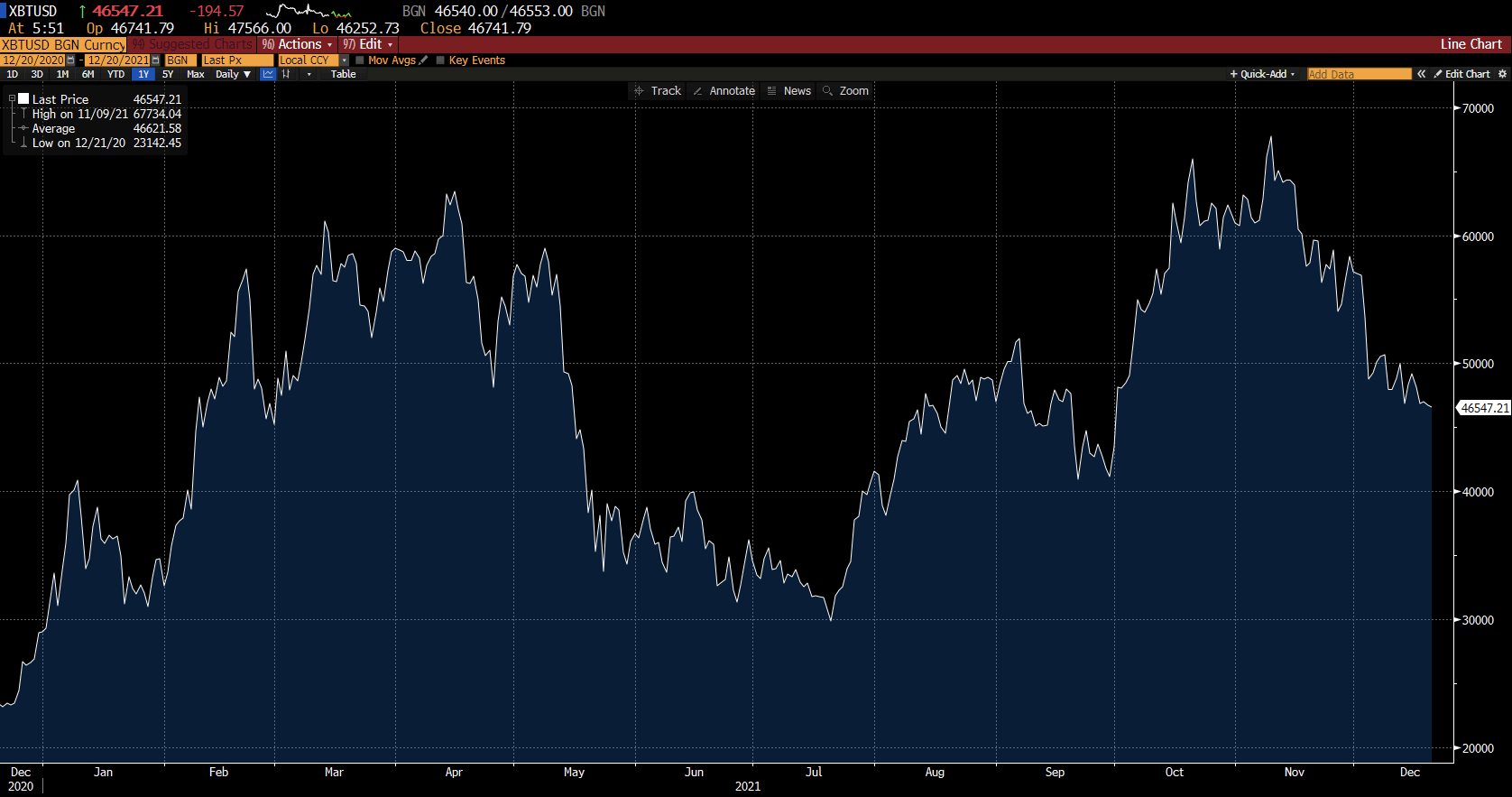US Indices
|
Name of the index |
Friday’s close |
Net Change |
Net Change (%) |
|
Dow Jones Industrial (US 30) |
35,365.44 |
-285.51 |
-0.80% |
|
S&P 500 (US 500) |
4,620.64 |
-48.33 |
-1.04% |
|
Nasdaq (US Tech 100) |
15,801.46 |
-281.09 |
-1.75% |
Source: Bloomberg
All 3 major US stock indices closed last week in the red, as the markets assessed the Federal Reserve’s newest signals to potentially raise interest rates multiple times next year.
In its final meeting of the year, Federal Reserve chairman Jerome Powell remarked hawkishly on the Fed’s monetary policy outlook, with forecasts from the Federal Open Market Committee (FOMC) projecting up to 3 interest rate hikes before the end of 2022.
“We’re in a position where we’re ending our taper by March, in two meetings, and we’ll be in a position to raise interest rates as and when we think it’s appropriate,” Powell remarked at the press conference.
Equity markets initially absorbed the news well, before rethinking their stance. The Dow Jones, S&P 500, and the Nasdaq Composite all rose sharply on Wednesday, 15 December 2021. Markets seemingly correlated a hawkish Fed stance with an optimistic, confident macroeconomic outlook — one that no longer needs the stabilizer wheels of low-interest rates to keep its economy from tipping.
However, mid-week gains from Wednesday’s rally were quickly wiped out during Thursday’s session and again during Friday’s close. The Dow Jones ended the week down by 1.65%, whilst the S&P 500 dropped 89.66 basis points, ending the week 1.90% lower. The Nasdaq Composite drew up the heaviest hit, shedding 451.59 points to close the week trailing at -2.89%.
In an environment with increasing rates and reducing liquidity as the Federal Reserve accelerates its asset purchase taper, long-term growth and technology stocks are being pressured, as both are valued heavily on future earnings potential.
Contrary to this, cyclical stocks across the financial and energy sectors outperformed the rest of the market on Friday, 17 December 2021, as rising interest rates boosted growth in these sectors.
Forex
Last week, the US dollar gained as traders took flight from riskier currencies. Their decision was triggered by the central bankers’ chatter of interest rate hikes and concerns about the rise in Omicron cases.
The US dollar index was up by around 0.6% during afternoon trading on Friday, 17 December 2021. After recovering its lost value from Thursday’s Fed-induced market dive, the dollar ended the week 0.67% higher.
The euro and the British pound dropped by 0.6% and 0.8% respectively after booking gains the two previous days. In Friday’s late session, the euro stood at $1.1247 and the pound at $1.3239.
Throughout last week, traders kept close tabs on the British pound’s price movements. In response to a surprise interest rate hike from the Bank of England (BoE), the GBP/USD pair reached a mid-week high of $1.337 for the first time since late November. Since the beginning of the pandemic, the BoE is the first central bank to raise interest rates.
As crude oil prices dropped by 2% on fears that Omicron will reduce global demand, commodity-linked currencies, including the Australian and Canadian dollar, fell against the US dollar. Meanwhile, the Japanese yen traded flat against the US dollar.
Commodities
Oil prices fell for the week, as fears grew that a new restriction may depress fuel demand due to increased cases of Omicron. In the past week, Brent crude dropped by 2.6%, settling at $73.52 a barrel, and WTI fell by 1.3%, dropping to $70.86 a barrel.
The number of oil rigs in the United States increased during the week, raising concerns about potential oversupply. It is possible that OPEC+ could meet before their scheduled meeting on 4 January 2022 if changes in the demand outlook warrant a review of their plans to add 400,000 barrels per day of supply in January.
Concerns over the Omicron surge and rising inflation drove traders to safe-haven assets on Friday, 17 December 2021, causing gold to climb above $1,800 for the first time in 5 weeks. The Federal Reserve’s forecast of up to 3 rate hikes next year would typically weigh on gold as higher interest rates increase the opportunity cost of holding non-yielding bullion. However, gold gained despite inflows into the US dollar, which is also considered a store of value during uncertain times.
XAU/USD closed at $1,798 on Friday, 17 December 2021. The pair is currently trading right under its resistance at the 61.8% retracement level, near $1,801. If gold breaches the 61.8% retracement level, its new resistance will be at the 78% retracement level near $1,834.
It will be interesting to see how traders react to the upcoming festive session and US macroeconomic events for the week, such as the US GDP (Q3), Consumer Confidence and the Unemployment Claims.
Cryptocurrencies
Crypto prices continue their downward trend as the central banks adopt an aggressive stance towards inflation. The price of Bitcoin (BTC), Ethereum (ETC), Binance Coin (BNB) and Cardano (ADA) fell between 3%-5% for the week. However, the market capitalisation is still well below the $2.3 trillion mark.
Bitcoin has declined for the fifth consecutive week. It has been hovering around the $50,000 mark for quite some time and has fallen well short of its peak in November, which was around $70,000.
Eswar Prasad, a senior professor on international trade policy at Cornell University, quoted that “Bitcoin itself may not last that much longer” because there are many alternatives to Bitcoin, some of which are more environmentally friendly.
On Friday, 17 December 2021, Bitcoin closed the week at around $46,850. A weekly chart shows it trading near $47,900, close to the 50% retracement level. According to the Simple Moving Average, the 21-week Moving Average is around $51,900, and the 50-week Moving Average is roughly $47,600, determining the near support and resistance levels.
Trade the financial markets with options and multipliers on DTrader or CFDs on Deriv X Financial account and Deriv MT5 Financial and Financial STP accounts.
Disclaimer:
Options trading, and the Deriv X platform, are not available for clients residing within the European Union or the United Kingdom.
Cryptocurrency trading is not available for clients residing within the United Kingdom.



